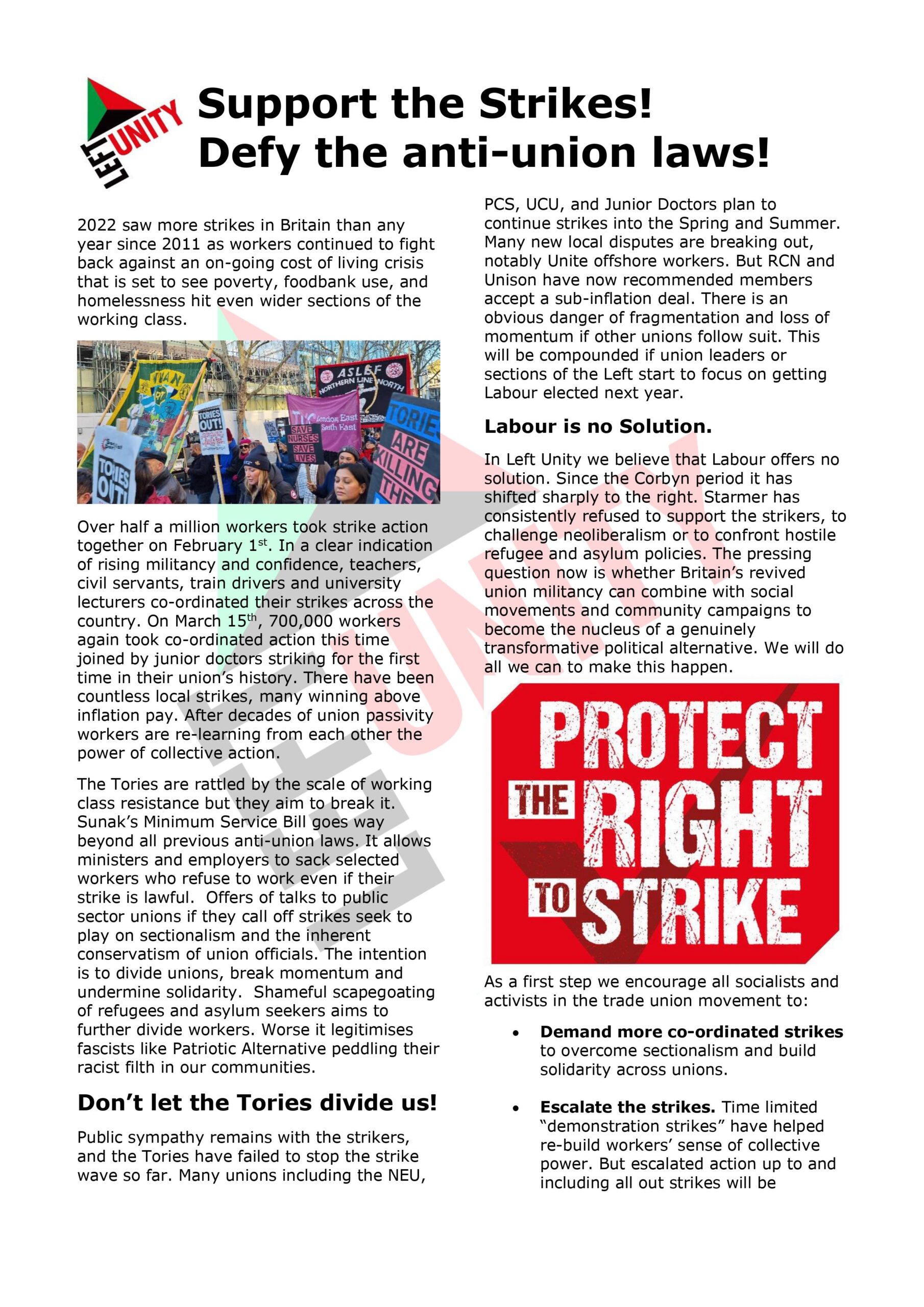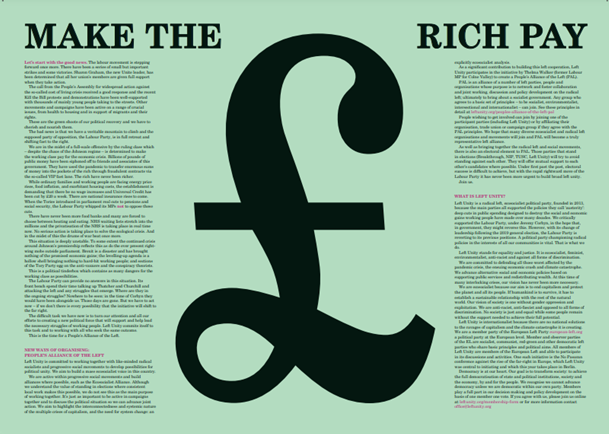Left Unity Policy Conference: workshop reports
 Pete McLaren reports from Left Unity’s policy workshop conference, held in Manchester on 28 September, focusing on the internal democracy and constitution sessions.
Pete McLaren reports from Left Unity’s policy workshop conference, held in Manchester on 28 September, focusing on the internal democracy and constitution sessions.
There were around 75 Left Unity members/supporters present at the Policy Conference. The day was divided into three sessions with workshops on most of the areas covered by Policy commissions including health, education, environment, immigration and the economy. Amongst the most popular were the two on Left Unity’s possible constitution which took place in two of the sessions from 1.15 – 5pm. It is referred to in this report as the Policy Commission (PC) draft, and can be found at http://leftunity.org/constitution-working-draft-5/
The first workshop session dealt with Membership, Structure and guiding principles, and Sections and Caucuses/Platforms. Eighteen comrades attended. Richard Murgatroyd, in the Chair, began by outlining 14 controversial issues that had arisen in the course of discussion. The main ones were:
- Should LU be OMOV or federation of groups – how far should we apply the principle of OMOV?
- Should members of other political parties be allowed to be a member of LU?
- Should the organisational structure make provision for regional and national bodies?
- Should we move to a delegate conference?
- What kind of leadership body should LU have, and how should it be elected?
- Should LU have 50% representation of women and men at all levels/
- How do we ensure internal accountability and avoid careerism?
- Should we allow platforms/caucuses/sections – and should they have representation?
- Should there be provision for trade union affiliation?
- Should oppressed groups – LBGT, disabled, black – have rights as separate sections?
- How should we use e-democracy and the internet for policy debates and elections?
In the event, most of these were, at least partially, covered, with some indicative votes taken. There were three draft Constitutions to consider – the main one from the Constitution Policy Commission (PC) motivated by Richard Murgatroyd and James Youd, together with a submission by Sean Thompson, and another by Terry Conway/Alan Thornett. All three were briefly motivated. James Youd referred to the local LU branches needing a minimum of 10 members, the need for 50/50 gender representation and the need for sections and caucuses (which seem to have replaced platforms in most drafts). He also spoke about the National Council which, it was being suggested, was composed of 14 elected Policy spokespeople, 5 elected by national conference, and 30 elected by Regional Councils, including a Council for the North of Ireland if 50 members joined LU from the province. An Executive of 14 would be elected 50/50 by Conference and members by OMOV
In motivating his draft, Sean Thompson suggested his Constitution only differed in points of detail from the PC one motivated by James Youd, although he strongly opposed the inclusion of representation for Northern Ireland. His draft also had no provision for associate membership, with some differences in terms of how a National Council and Executive should be elected.
Alan Thornett accepted the draft put forward by him and Terry Conroy left out issues which would need to be addressed, including selection procedures and trade union affiliation. He stressed the need for a political, functioning leadership, with an Executive elected by the National Council.
Discussion then took place around specific items of the main Policy Commission Constitution broken down into a number of sections. The Aims (Policy Commission Point 2) were not discussed – we were told there would not be time.
CONDITIONS OF MEMBERSHIP (Policy Commission (PC) Point 3)
Right at the start, I made the point that the stated aim in the PC draft Constitution of uniting the left – the ‘diverse strands of radical and socialist politics in the UK’, including workers’ organisations, trade unions, co-operatives, environmental and democracy campaigns: all who seek to voice and represent the interests of working people – suggested that we needed to find a way of encouraging involvement and affiliation of such organisations. The Chair agreed it was an important issue, but it was then barely addressed. Other points made in the discussion included:
- Associate membership, as suggested by the PC draft, would help draw people in, acting as a bridge into full membership. It would also be a way of involving trade unions
- We should encourage trade unions to affiliate, but avoid the use of a block vote
- The PC draft has provision for work-based branches – that could be a way of involving trade unions.
- The issue of trade union involvement is not a live issue at present but could be re-visited
An indicative vote did not support there being Associate members as envisaged in the PC draft
STRUCTURE AND GENERAL PRINCIPLES (PC draft Point 4)
General points made included:
- This could be an appendix, not a section of the Constitution itself
- Individual members may well relate to caucuses
Specifically on the question of whether or not women should constitute at least 50% of delegate positions as recommended in the PC draft constitution, the following were amongst points made:
- We need to do more to encourage the involvement of women rather than having quotas
- We can not have a bureaucratic solution to a political problem
- Another formula would be to have a 40/40 male female balance, leaving 20% of positions open
- The Constitution should state we will aim for 50/50 representation so that we work towards it
- The left is too male dominated and women are suffering disproportionately from austerity. We will be behind the times if we don’t commit to 50/50. Left Unity should be making a bold statement
It was agreed there was a general consensus for some positive action, but not necessarily 50/50
SECTIONS AND CAUCUSES (PC DRAFT Point 7)
Richard Murgatroyd explained that Sections were for sectional interests including youth, women and black. Caucuses, like platforms, were a way for those with similar political interests to organise. The PC draft was recommending the continued existence of caucuses; the question was, should they be able to promote resolutions? The following were amongst points made in the discussion:
- Caucuses should be able to become permanent factions
- Caucuses should be able to put forward resolutions – an individual can with the support of 20 members
- An individual with the support of 20 members for their resolution has effectively formed a caucus
- The NC should not have to agree the existence of a caucus. People do not need permission to organise for themselves
- Candidates for internal posts should not have to declare membership of a caucus
- Caucuses cut across the principle of OMOV
- We could add the need for specific named sections to the Constitution
- Having sections can be seen as divisive – they section people off
- We need to protect the rights of minorities.
SECOND SESSION AFTER 15 MINUTE BREAK
Thirty five people attended this session. Richard Murgatroyd, in the Chair, began by giving a brief summary of what had been discussed in the previous session
NATIONAL/ANNUAL CONFERENCES (PC draft Point 9)
Richard Murgatroyd began by asking if and when comrades felt Conferences should be on a delegate basis. The PC draft suggested it was when LU reached 2,000 members. The following were amongst the responses:
- The Constitution is ambitious for an organisation of our size – Conferences open to all members should remain as long as possible
- We should move to delegate conferences as soon as possible
- Open Conferences are skewed towards those living within easy travel, and those in organised groups
- Delegate Conferences enforce branches to discuss each issue in turn in order to mandate their delegate
In terms of how resolutions should be put forward, the following points were amongst those made:
- Any individual member should have the right to move a resolution – why do they need 20 signatures of support as suggested in the PC draft?
- It should be a fundamental right of membership to be able to initiate policy discussion as an individual
- 2,000 members could mean 2,000 resolutions
- Individuals should not be able to move resolutions on their own: they should put it up on the web site and see if they can get the support of 20 members
- Democracy should be based on branches, not individuals
ENGLISH REGIONAL, SCOTTISH AND WELSH STRUCTURES (PC draft Point 9)
The discussion began with points made as to whether the North of Ireland should become a LU region. The following were amongst points made about that and other aspects of regional/national structures:
- Wales and Scotland are nations, the North of Ireland is not
- Left Unity, like the TUC, should organise across Ireland as a whole
- It will take time for regions to develop – this does not need to be in the Constitution
- If we insist on a membership of 10 for a branch to be formed there will be a lot of areas with members but no branches and a regional structure could help them to organise
DIRECT DEMOCRATIC PARTICIPATION, THE INTERNET AND E-CONFERENCES (PC draft Point 10) Points made included:
- We should use the internet as much as possible, but we must find ways of fully involving members not on the internet
- People with visual and hearing disabilities are less able to use the internet
- Internet use should be maximised without cutting across Conference
- We should find ways of encouraging and assisting use of the internet
It was generally agreed that internet discussions should not, on their own, be binding on policy
NATIONAL COUNCIL AND EXECUTIVE COMMITTEE (PC draft Point 12)
Richard Murgatroyd opened the debate by outlining the composition of the proposed National Council (NC) – 30 regionally elected reps, 5 nationally elected officers with no voting rights, 14 nationally elected spokespeople with specific policy remits. The NC would meet 8 times a year. There would also be an executive committee of 7 nationally elected officers and 7 regional reps elected from and by the regional reps on the NC. Sean Thompson’s draft suggested an NC of regionally elected reps, youth and student reps and an executive ctte consisting of 5 nationally elected officers and 10 others elected by Conference. Terry C and Alan T’s draft suggested a NC of 30 regionally elected reps, 3 national officers elected by Conference and 17 others elected by Conference. The Executive committee would consist of 4 national officer and 16 others elected by the NC
A wide ranging discussion followed, and these were amongst the points made:
- Having regionally elected reps may not be representative because of in-balances between regions
- There should be representation for oppressed groups and sections on the NC
- Caucuses should be represented on the NC
- Some individuals may not be able to attend branch meetings, or there may be no local branch. Caucuses and sections could give them representation
- OMOV would involve those not able to get to branch meetings
- There was no reason to have policy spokespeople or Principal speakers – it would appear elitist, especially whilst LU remained a relatively small organisation
- Having Policy spokespeople would be unworkable. Who would decide what was relevant?
- Officers should be elected by National Conference
- Regional reps should be elected by regional councils and should constitute at least 50% of the NC
- We need to avoid having an over-powerful Executive – the NC should be the main forum between Conferences
- Independent socialists get no direct representation through any of these models
- As knowledge is power, every branch should be directly represented within the LU hierarchy, either at an enlarged NC, or through an additional body to which the NC and officers are accountable.
- LU’s structure should be based on its branches
- There needs to be an Executive that is small enough to function
The session concluded with some indicative votes on a number of issues, as follows:
- Should the leadership be elected by OMOV or delegates at Conference? It was overwhelmingly agreed by OMOV
- Should sections for the oppressed be represented on leadership bodies? – Generally agreed
- Should there be Policy Spokespeople and Principal Speakers? – Strongly opposed
- Should the Executive be elected by OMOV or by the NC? – OMOV was generally favoured
5 comments
5 responses to “Left Unity Policy Conference: workshop reports”
Left Unity is active in movements and campaigns across the left, working to create an alternative to the main political parties.
About Left Unity
Read our manifesto
Left Unity is a member of the European Left Party. 
Read the European Left Manifesto
ACTIVIST CALENDAR
Events and protests from around the movement, and local Left Unity meetings.

Saturday 29th November: National Demonstration for Palestine
END THE OCCUPATION – STOP ARMING ISRAEL – END APARTHEID
12 noon central London
More events »
GET UPDATES
Sign up to the Left Unity email newsletter.
CAMPAIGNING MATERIALS
Get the latest Left Unity resources.



Some interesting ideas here to chew on.
Could we please change OMOV to OPOV (that is, One Person One Vote.)
Alan Story
LU Notts
I think One Member One Vote is more appropriate in the context of a constitution of a political party.
Tim:
I assumed OMOV meant One Man One Vote…as it usually/often does.
If at the start of the doc, there were the words ‘ One Member/ One Vote (OMOV)’
, that would clarify things.
I guess we have to all get used to there being LU ( or whatever are the chosen words) party ‘members.’
Alan Story
You’re right about clarifying OMOV – it’s an abbreviation and abbreviations should be spelt out first time they’re used.
I’m proud to be a founding Member of [LU] so very happy to be able to use the word!
Im disappointedc by the language around disabled people. The SOcial Model of Disability explains that people have impairments, not disabilities. Being disabked is a political state. Disabled people, are people with impairments who are disabled by the structures, institutions and practices of the state and society.
The language above, around PC point 10, is terrible. Why do you assume blind or deaf people are ‘less able’ to do anything never mind use the internet? All the blind people I know use the internet perfectly well when the have the right equipment. This kind of language re-inforces the image of thepitiful, tragic crip needing help to function in the world. And that LU can bestow some gifts of help upon us. As disabled people have shown for decades, we arent here to be pitied. We want rights, not charity.
This was the first bit of yer internal documents ive gone through, and im deeply disappointed that a group claiming to want to challenge the old guard ways of operating have been so slow to think about such critical political topics as this.